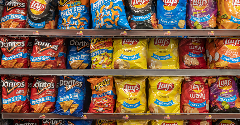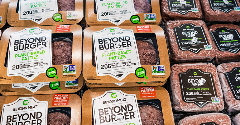News
Ancient grains have become household names
28 May 2018Until very recently, few consumers had heard of quinoa – and even fewer knew how to pronounce it. Now, it is one of the most sought-after grains, appearing in over 2,200 new products launched globally in 2017, according to Mintel.
Ancient grains are appearing in an increasing number of foods, as global consumers seek healthy, wholesome alternatives to traditional grains. From snacks and cereals, to baked goods and even dairy and beverages, manufacturers are finding diverse ways to tap into this growing trend.
Many ancient grains have become household names in the past few years, including quinoa, buckwheat and chia. From 2014 to 2015, the number of new foods and drinks launched globally containing chia grew 70%, for example, according to Mintel’s Global New Products Database, while those containing quinoa rose 27%. Others such as teff, amaranth, freekeh, khorasan wheat, millet and sorghum are also turning up in a range of products, not only for their nutritional value, but also to add a distinctive taste and texture.

Mintel Group says German consumers are particularly interested in ancient grains, where they have been used in wholegrain bread for centuries. However, they are now benefiting from new positioning as ancient grains or supergrains, extending their appeal to a younger generation of consumers. While 30% of German adults are interested in trying bread containing superfood grains or seeds, interest among those aged 25-34 reaches 46%. Meanwhile, 30% of pasta consumers in the UK think that pasta made with ancient grains is healthier than regular pasta, the market researcher says.
Sprouted grains have also gained ground as consumers have become more aware of their nutritional benefits. Sprouting increases the amount and bioavailability of certain vitamins and minerals, and may make grain proteins easier to digest.
Many ingredient suppliers have extended their range to tap into this demand for ancient grains in a variety of forms.
Taura Natural Ingredients , for example, has incorporated chia and amaranth into real fruit flakes for use in breakfast cereals. It says this solves a common problem associated with dense ancient grains that tend to sink to the bottom of the bowl when milk is added, while also providing an appealing flavour.
In 2016, Corbion Caravan launched a range of pre-soaked ancient and whole grains that are not treated with preservatives, allowing companies to incorporate grains like oats, millet, amaranth, chia, cracked wheat, whole grain barley, whole rye kernels and quinoa into baked goods, while also meeting consumers’ clean label expectations.
Meanwhile, GoodMills Innovation released its 2ab Wheat last year, an ancient wheat variety said to be suitable for those with gluten sensitivity (although not for those with coeliac disease). Apart from this particular variety of ancient wheat, consumers who suffer from gluten sensitivities or intolerance are attracted to ancient grains that are free from gluten, the protein in wheat, barley and rye. Gluten free options include amaranth, quinoa, chia and sorghum, and offer a nutritional boost and improved texture in gluten free baked goods and snacks.
While many food trends are met with scepticism about their longevity, the rise of ancient grains looks set to continue as it taps into so many current market trends, including for high protein, minimally processed foods, as well as the move toward more plant-based eating.
Related news

PepsiCo formulates ‘naked’ Cheetos and Doritos products
31 Dec 2025
US food giant PepsiCo has launched its Simply NKD range, a move it says reimagines its popular products with new formulations free from artificial flavours, dyes, and colours.
Read more
Debate over ban on ‘meaty’ names for plant-based products reaches stalemate
26 Dec 2025
The debate over a ban on plant-based products using “meaty” terms has reached a stalemate, leaving manufacturers in limbo and still facing overhauls to their marketing and packaging.
Read more
Has ‘clean’ had its day?
22 Dec 2025
Wielding clean-label positioning and fortification as marketing levers is a dangerous strategy, and brands would be better off explaining the hows and whys of the ingredients in their products, say experts.
Read more
Bigging up bean-based products and consumption in Britain
19 Dec 2025
Non-profit organisation the Food Foundation has launched a campaign, “Bang in Some Beans”, designed to increase UK consumers’ legume consumption.
Read more
Ingredient transparency key to success in European natural health market
12 Dec 2025
Europe’s $40.7 billion supplements market is growing fast, fuelled by demand for products that support healthy ageing, mental wellbeing, and preventive health, say experts.
Read more
Sorghum emerges as better-for-you hero ingredient
9 Dec 2025
With the launch of Novak Djokovic’s sorghum-based brand, the grain’s popularity in the better-for-you snacking sphere is on the rise, thanks to its nutritional and sensory properties.
Read more
Innovation promise in 'maturing' plant-based dairy alternatives market
8 Dec 2025
Plant-based dairy is a maturing market that still faces significant hurdles around taste, functionality, nutrition, and price, but industry is innovating fast, according to experts speaking at Fi Europe.
Read more
Celebrating the winners of the Fi Europe Innovation Awards 2025
3 Dec 2025
Food industry stakeholders celebrated as the winners of the Fi Europe Innovation Awards were announced at a ceremony in Paris.
Read more
Yuka’s food scanning app helps consumers make healthier choices
2 Dec 2025
Global food scanning app Yuka helps consumers understand the content of their shopping baskets and shapes producers’ reformulation plans.
Read more
Non-UPF Program extends certification scheme to entire food industry
30 Nov 2025
The Non-UPF Program has extended its certification scheme to the wider food sector, championing a move towards healthier consumption habits.
Read more